Frecce Tricolori
The Frecce Tricolori ([ˈfrettʃe trikoˈloːri]; literally "Tricolour Arrows"), officially known as the 313° Gruppo Addestramento Acrobatico, Pattuglia Acrobatica Nazionale (PAN) Frecce Tricolori ("313th Acrobatic Training Group, National Aerobatic Team (PAN) Frecce Tricolori"), is the aerobatic demonstration team of the Italian Air Force. Based at Rivolto Air Base, province of Udine, it was created on 1 March 1961 as a permanent group for the training Air Force pilots in air acrobatics.[1].
| Frecce Tricolori 313° Gruppo Addestramento Acrobatico | |
|---|---|
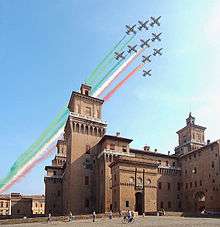 The Frecce Tricolori, with green, white, and red smoke trails, above the Estense Castle, Ferrara, Italy. | |
| Active | 1 March 1961 to date |
| Country | |
| Branch | |
| Role | Aerobatic display team |
| Garrison/HQ | Rivolto Air Force Base, Codroipo, Province of Udine, Friuli-Venezia Giulia, Italy |
| Colors | National colours of Italy |
| Insignia | |
| Frecce Tricolori Badge | 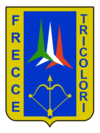 |
| Aircraft flown | |
| Fighter | 1961 – 1963 Canadair F-86E 1964 – 1981 Fiat G.91 PAN |
| Trainer | 1982 - present Aermacchi MB-339-A/PAN |
The Tricolour Arrows replaced unofficial teams that had been sponsored by various commands starting in the early 1930s.[2] The team flies the Aermacchi MB-339-A/PAN, a two-seat fighter-trainer craft capable of 898 km/h at sea level.[2][3] With ten aircraft, nine in close formation and a soloist, they are the world's largest acrobatics patrol, and their flight schedule, comprising about twenty acrobatics and about half an hour, made them the most famous in the world.[4] It is one of national symbols of Italy.[5]
History
Previous patrols
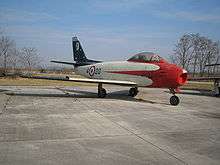
In Italy the first acrobatic flight school was founded in 1930 at the Udine-Campoformido Airport on the initiative of Colonel Rino Corso Fougier, commander of the 1st Fighter Wing: the first formation consisted of five Fiat C.R.20 and already on 8 June 1930 at first air show, called "Wing Day", these planes performed in a "bomb", a figure similar to the current bomb.[1]
In the years before the World War II the patrol of the Regia Aeronautica participated in various events (to note is that in 1932 Breda Ba.19 was used, in 1934 Fiat CR.30 and from 1936 Fiat CR.32), among which in 1938 the inauguration of the Milan-Linate Airport during which the Chief Patrol was Bruno Sartori, Silver Medal of Military Valor.[6]
After the inevitable parenthesis of the 1939-1945 period the acrobatic patrol was dissolved and reformed after the war, even if not officially classified as an acrobatic patrol. It was in fact the 51st Fighter Wing, equipped with US P-51D Mustang and British Spitfire Mk.IX aircraft, the first to perform with three Spitfires at Padua Airport in September 1947. The enthusiasm of these pilots was soon followed by some of their colleagues of the 5th Wing, which formed another aerobatic team based on Spitfire aircraft.[7]
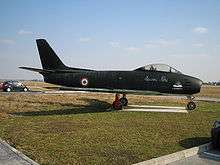
In 1950 a patrol called Cavallino Rampante (Prancing Horse) formed, consisting of four pilots of the 4th Wing equipped with D.H.100 Vampire aircraft[1]. In parallel with this department, in 1953 the Guizzo (Wriggle) was established, coming from the 5th Wing and operating on F-84G Thunderjet aircraft. This unit participated by gaining considerable success at various shows throughout Europe, thanks also to the return of the acrobatic maneuver called "bomb": the four pilots at the top of a looping in formation swooped down in opposite directions, calling the plane only near the ground.[8] The notoriety of Guizzo grew to such an extent that in 1955 he was given a film called The four of the thundering jet (in honor of the Thunderjet), and it was thanks to this film that the department officially changed its name to Getti Tonanti (Thundering Jets), continuing to perform until 1956, when they were replaced by the Tigri Bianche (White Tigers) of the 51st Fighter Wing, always mounted on F-84G[1].
After a successful year, this new acrobatic team gave way to the reborn Cavallino Rampante and its new F-86E Saber, which will begin operations on May 19, 1957 at the Turin Airport, reaching its peak with the exhibition at the international exhibition of aeronautics and space in Paris Air Show. Many artistic victories also derived from the fact that, for the first time in Italy, a white smoke generator was used, with which the acrobatic figures were particularly highlighted.[9] 1957 also saw the entry into the scene of two new acrobatic departments: the Diavoli Rossi (Red Devils) and the Lanceri Neri (Black Lancers). The former were on staff at the 6th Fighter Wing, and with their F-84F Thunderstreak they achieved a great consensus among the population, as shown by their tour in the United States of America; the latter instead came from the 2nd Aerobrigata, demonstrating, with the help of the F-86E, great operational ability, which led them to fly also in Iran in 1959 in the presence of the Shah Mohammad Reza Pahlavi[6].
In 1959 the Getti Tonanti line-up equipped with F-84F was also reconstituted, whose livery will be modified in 1960 with the five circles of the Olympic flag on the occasion of the 1960 Summer Olympics held in Rome[6].
Birth of the Frecce Tricolori
.jpg)
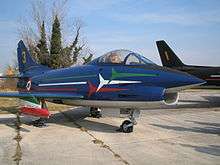
Towards the end of 1960 it was decided to end this shifting between the various flocks and to found a department whose specific purpose was to form the national aerobatic team, selecting the best pilots of the various departments[1].
Major Mario Squarcina, leader of the Diavoli Rossi was thus commissioned by the General Staff of the Italian Air Force to establish the Pattuglia Acrobatica Nazionale (National Aerobatic Patrol) composed of pilots from all the Air Force departments. The 313th Aerobatic Training Group was founded on 1 March 1961 at the Rivolto Air Base[1]. On the same day, 6 North American F-86 Sabers of the 4th Air Brigade took off from Grosseto to Rivolto. On 1 May 1961 the first official release of the Pattuglia Acrobatica Nazionale (P.A.N.) with the high program of 4 + 1 F86 Saber on the airport of Trento - Gardolo, on the occasion of the Air Show of the local Aero Club. Unfortunately, three days later, on May 3rd, there was an incident in flight, during which a pilot died.[10]
The Frecce Tricolori flew on North American F-86 Sabre until 1963[1]. The staff, initially not as numerous as today, was enlarged in 1963 to nine elements plus the soloist, adding the possibility of using colored fumes. The following year the Fiat G.91PAN fighter-bombers arrived, then moved to the current Aermacchi MB-339 A/PAN MLU in 1982[1].
On 28 August 1988 the PAN was the protagonist of the Ramstein accident, in which three pilots and 67 spectators lost their lives. Two of the three dead pilots, Mario Naldini and Ivo Nutarelli, were supposed to testify at the trial for the Itavia Flight 870 a few days later. This was the cause of various suspicions about the actual nature of an "accident" of what happened[11]
In 2000 they reached 50,000 flying hours on the Aermacchi MB-339.[12]
In 2005 they won the award for best exhibition at the Royal International Air Tattoo at Fairford, England. They were the first non-Russian unit to receive the Russian Silver Medal for Aeronautical Merit.[13][14] On 8 September 2007 the Frecce Tricolori took part at the funeral of Luciano Pavarotti in Modena and honoured him with a fly-past leaving green-white-red smoke trails.[15]
The replacement (scheduled for 2017) of the MB-339PAN with Alenia Aermacchi M.345 HET (High Efficiency Trainer), announced in 2013, was blocked in 2014, reconfirmed in 2016 with entry into service scheduled for 2020.[16]
Description
Aircraft features
The livery of the MB-339PAN used by the Group is given by the characteristic tricolor band that crosses the side of the plane against a savoy blue background. The airplane's abdomen is light gray while the formation numbers are yellow stickers. For the classic Aermacchi MB-339 A under the Italian Air Force the wingtip tanks were removed for two reasons[17]:
- penalize the acrobatic performance of the aircraft, in particular the fast tonneaux due to a considerable mass placed far from the axis of rotation;
- would make it more difficult to maintain tight formation during acrobatic maneuvers, partially inhibiting the view of the aircraft next to which one is flying and thus depriving the "gregari" of precise reference points for maintaining the position.
Mixed subalary tanks are thus created, containing both vaseline oil for fumes and a certain amount of fuel to partially compensate for the reduction in autonomy caused by the removal of tip tip tanks. Larger subalar fuel tanks (pylon tank), already provided for at the origin, can be installed on the external subaltern pylons for long-range transfer flights[17]. On the occasion of the first cruise in USA-Canada (1986), special cylindrical tip tanks were set up, with a capacity much higher than that of the original elliptical tip-tank[17]. These cylindrical tip tanks, added to the nylon tanks, provide adequate autonomy for large stops in the north Atlantic, allowing even a digression on a possible diversion airport.
The colored smoke is generated by dispersion, and is composed of vaseline oil to which non-polluting pigments are added[17]. The escape of this compound occurs through a small tube placed in the rear exhaust of the airplane[17].
Formation
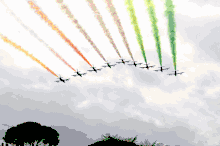
During the performances the formation of the acrobatic patrol is usually composed of 9 aircraft, called "Pony", each labeled with a number ranging from 1 to 10.[18][19] The name "Pony" was coined by the then Captain Zeno Tascio to remember the horse of Francesco Baracca[20] which is the sign of the 4th Wing, at the time 4th Airbase who was already preparing to take over the task PAN for the 1961. Depending on the needs of the Department, aircraft can also be 11 in total, thus including the figure of the acrobatic training manager.[21]
- Pony 0 - Commander
- Pony 1 - Head of Formation
- Pony 2 - 1° Left Domestique
- Pony 3 - 1° Right Domestique
- Pony 4 - 2° Left Domestique
- Pony 5 - 2° Right Domestique
- Pony 6 - 1° Tail light
- Pony 7 - 3° Left Domestique
- Pony 8 - 3° Right Domestique
- Pony 9 - 2° Tail light
- Pony 10 - Soloist
- Pony 11 - Acrobatic Training Supervisor
- Pony 12 - Pilot in Training
- Pony 13 - Pilot in Training
- Pony 14 - Pilot in Training
- Pony 15 - Pilot in Training
- Pony 16 - Pilot in Training
Flight programs and pilot selection
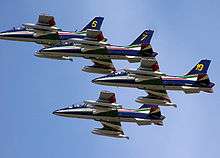
The Frecce Tricolorihave three programs for performing acrobatics: high, low, and flat, depending on the weather conditions and the characteristics of the exhibition area[3]. The high program is chosen when the cloud base is above 1,000 m and is characterized by the execution of the acrobatic figures entirely on the vertical plane; the low program is preferred instead when the clouds do not exceed 500 - 600 m and vertical maneuvers are not carried out (such as looping or the bomb); finally, the flat variant includes low-level formation maneuvers.
For several years, when possible, the PAN performances have ended with the complete line-up drawing a five km long flag of Italy in the sky while from the floor speakers the voice of Luciano Pavarotti intones the finale of Nessun dorma for the entire duration of the passage . The first realization of this maneuver took place in Pratica di Mare (frazione of Pomezia) during the farewell ceremony at the F-104 Starfighter and this earned the Frecce Tricolori the world record for the longest national flag ever made. Also for this reason, on September 8th, 2007, hurtling through the Modena sky, the Frecce Tricolori paid tribute to Pavarotti whose funeral he had just helde[22][23].
Only the best pilots have access to the Frecce Tricolori: each year one or two of them are chosen strictly among those who have more than 1,000 flight hours, and once they have entered they must follow a gradual insertion training program.[24]
Incidents
Below is a list of the accidents that occurred to the pilots of the Frecce Tricolori[25]:
| Rank | Pilot | Aircraft | Serial numb. | Position | Circumstance | Consequence | Place | Date |
|---|---|---|---|---|---|---|---|---|
| Captain | Massimo Raffaello Scala | F-86E Sabre | 19505 | Pony 3 | Training | Dead | Rivolto Air Base | 3 May 1961 |
| Lieutenant | Gianni Pinato | F-86E Sabre | 19638 | Pony 4 | Training | Unharmed | Rivolto Air Base | 3 May 1961 |
| Captain | Gianbattista Ceoletta | F-86E Sabre | 19521 | Training | Unharmed | Rivolto Air Base | 21 August 1961 | |
| Captain | Mauro Venturini | F-86E Sabre | 19572 | Training | Dead | Rivolto Air Base | 30 August 1961 | |
| Senior master sergeant | Eugenio Colucci | F-86E Sabre | 19611 | Pony 5 | Air Show | Dead | Forlì | 5 May 1963 |
| Marshal | Ennio Anticoli | F-86E Sabre | 19629 | Pony 8 | Air Show | Unharmed | Forlì | 5 May 1963 |
| Captain | Raffaele D'Andretta | Fiat G.91PAN | 6256 | Pony 3 | Training | Dead | Rivolto Air Base | 22 March 1967 |
| Captain | Giancarlo Bonollo | Fiat G.91PAN | 6252 | Pony 6 | Training | Unharmed | Bertiolo | 12 December 1969 |
| Captain | Valentino Jansa | Fiat G.91PAN | 6255 - 6 | Pony 9 | Training | Dead | Palmanova | 22 September 1971 |
| Major | Angelo Gays | Fiat G.91PAN | 6238 - 9 | Pony 7 | Air Show | Dead | Pratica di Mare | 2 June 1973 |
| Captain | Antonio Gallu | Fiat G.91PAN | 6239 - 13 | Pony 4 | Air Show | Unharmed | Pratica di Mare | 2 June 1973 |
| Lieutenant | Sandro Santilli | Fiat G.91PAN | 6259 - 15 | Pony 9 | Training | Dead | Rivolto Air Base | 14 March 1974 |
| Lieutenant | Ivano Poffe | Fiat G.91PAN | 6260 - 10 | Pony 7 | Training | Dead | Rivolto Air Base | 14 March 1974 |
| Captain | Graziano Carrer | Fiat G.91PAN | 6261 - 2 | Pony 2 | Training | Dead | Rivolto Air Base | 12 July 1978 |
| Captain | Andrea Di Paoli | Fiat G.91PAN | 6240 - 4 | Pony 4 | Training | Unharmed | Rivolto Air Base | 12 July 1978 |
| Captain | Piergianni Petri | Fiat G.91PAN | 6254 | Pony 2 | Air Show | Dead | Mildenhall (England) | 27 May 1979 |
| Captain | Vito Posca | Fiat G.91PAN | 6241 - 9 | Pony 4 | Training | Unharmed | Rivolto | 9 April 1980 |
| Captain | Pasqualino Gorga | Fiat G.91PAN | 6251 - 7 | Pony 9 | Training | Unharmed | Treviso | 29 June 1981 |
| Lieutenant Colonel | Antonio Gallus | Fiat G.91PAN | 566 - 12 | Pony 1 | Training | Dead | Rivolto Air Base | 2 September 1981 |
| Captain | Fabio Brovedani | Fiat G.91PAN | 6249 | Pony 2 | Training | Unharmed | Rivolto Air Base | 2 September 1981 |
| Major | Vito Posca | MB-339PAN | 54475 | Pony 1 | Transfer | Unharmed | Chiusaforte | 4 September 1984 |
| Lieutenant | John Miglio | MB-339PAN | 54476 | Pony 11 | Training | Dead | Rivolto Air Base | 20 February 1985 |
| Lieutenant Colonel | Mario Naldini | MB-339PAN | 54481 - 1 | Pony 1 | Air Show | Dead | Ramstein (Germany) | 28 August 1988 |
| Captain | Giorgio Alessio | MB-339PAN | 54474 - 2 | Pony 2 | Air Show | Dead | Ramstein (Germany) | 28 August 1988 |
| Lieutenant Colonel | Ivo Nutarelli | MB-339PAN | 54552 - 10 | Pony 10 | Air Show | Dead | Ramstein (Germany) | 28 August 1988 |
| Lieutenant Colonel | Paolo Scoponi | MB-339PAN | 54537 | Pony 10 | Training | Dead | Rivolto Air Base | 12 December 1988 |
| Captains | Andrea Braga Stefano Commisso |
MB-339PAN | 54497 | Pony 9 | Training | Unharmed | Rivolto Air Base | 27 October 2002 |
Gallery
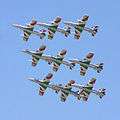
- Airshow, Fermo, 13 September 2015
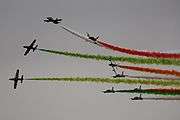 2016 Season Inauguration - Rivolto
2016 Season Inauguration - Rivolto The Frecce Tricolori race on the Molo Audace of Trieste, on the occasion of the last stage of the Giro d'Italia 2014
The Frecce Tricolori race on the Molo Audace of Trieste, on the occasion of the last stage of the Giro d'Italia 2014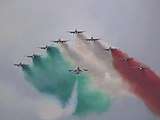 The Frecce Tricolori in Peschiera del Garda on 11 June 2006
The Frecce Tricolori in Peschiera del Garda on 11 June 2006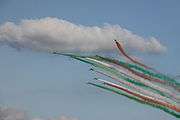 Frecce Tricolori at the Kecskemét Air Show.
Frecce Tricolori at the Kecskemét Air Show.
See also
- List of aerobatic teams
References
- "Storia delle Frecce Tricolori" (in Italian). Retrieved 15 October 2019.
- Aeronautica Militare official site
- Caliaro 2005, p. 25
- Caliaro 2005, p. 25.
- "Le Frecce Tricolori verso il 60esimo compleanno" (in Italian). Retrieved 15 October 2019.
- "La storia delle Frecce Tricolori" (in Italian). Retrieved 15 October 2019.
- Caliaro 2005, pp. 14-15.
- Caliaro 2005, pp. 15-16.
- Caliaro 2005, pp. 17-18.
- "3 marzo 1961: la nascita della P.A.N." (in Italian). Retrieved 15 October 2019.
- "Ustica, la denuncia choc: "L'incidente alle frecce tricolori fu un sabotaggio"" (in Italian). Archived from the original on 8 May 2017. Retrieved 16 June 2018.
- Aeronautica Militare official site
- Aeronautica Militare official site
- Aeronautica Militare official site
- "estense.com". Retrieved 11 February 2017.
- "Aermacchi M-345 HET, il nuovo aereo delle Frecce Tricolori" (in Italian). Retrieved 29 June 2019.
- "La storia delle Frecce Tricolori" (in Italian). Retrieved 15 October 2019.
- "Alla scoperta delle Frecce Tricolori" (in Italian). Retrieved 6 December 2011.
- "Le "Frecce Tricolori"" (in Italian). Retrieved 6 December 2011.
- "Pattuglie acrobatiche del 4º Stormo" (in Italian). Archived from the original on 2 February 2016. Retrieved 26 January 2016.
- "PAN: presentazione Poster e Formazione 2015" (in Italian). Retrieved 7 January 2015.
- "In 100.000 a rendere omaggio a Pavarotti" (in Italian). Retrieved 16 March 2008.
- "Funerali Pavarotti. L'ultimo saluto dalle Frecce Tricolori" (in Italian). Retrieved 16 March 2008.
- Caliaro 2005, p. 31.
- "Circolo della Pattuglia Acrobatica Nazionale - Per non dimenticare" (in Italian). Retrieved 14 October 2019.
Sources
- Luigino, Caliaro (2005). "Frecce Tricolori". Pattuglie acrobatiche. Mondovì: Edizioni Gribaudo. ISBN 88-8058-873-7.
External links
| Wikimedia Commons has media related to Frecce Tricolori. |
- Official website

- Aermacchi MB-339 PAN for Digital Combat Simulator
- Aermacchi MB-339 PAN for FlightGear
- Frecce Tricolori on Airliners.net
- Air14 Payerne